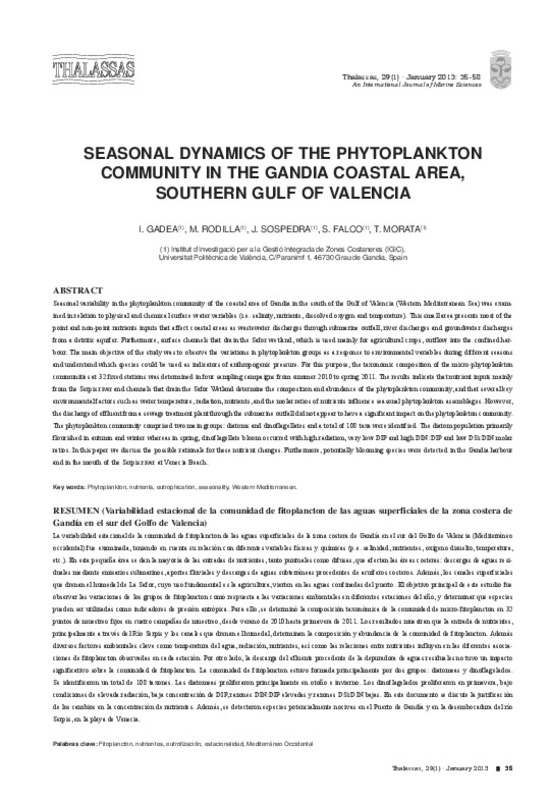|
Resumen:
|
[EN] Seasonal variability in the phytoplankton community of the coastal area of Gandia in the south of the Gulf of Valencia (Western Mediterranean Sea) was examined in relation to physical and chemical surface water variables ...[+]
[EN] Seasonal variability in the phytoplankton community of the coastal area of Gandia in the south of the Gulf of Valencia (Western Mediterranean Sea) was examined in relation to physical and chemical surface water variables (i.e. salinity, nutrients, dissolved oxygen and temperature). This small area presents most of the point and non-point nutrients inputs that affect coastal areas as wastewater discharges through submarine outfall, river discharges and groundwater discharges from a detritic aquifer. Furthermore, surface channels that drain the Safor wetland, which is used mainly for agricultural crops, outflow into the confined harbour. The main objective of the study was to observe the variations in phytoplankton groups as a response to environmental variables during different seasons and understand which species could be used as indicators of anthropogenic pressure. For this purpose, the taxonomic composition of the micro-phytoplankton communities at 32 fixed stations was determined in four sampling campaigns from summer 2010 to spring 2011. The results indicate that nutrient inputs mainly from the Serpis river and channels that drain the Safor Wetland determine the composition and abundance of the phytoplankton community, and that several key environmental factors such as water temperature, radiation, nutrients, and the molar ratios of nutrients influence seasonal phytoplankton assemblages. However, the discharge of effluent from a sewage treatment plant through the submarine outfall did not appear to have a significant impact on the phytoplankton community. The phytoplankton community comprised two main groups: diatoms and dinoflagellates and a total of 108 taxa were identified. The diatom population primarily flourished in autumn and winter whereas in spring, dinoflagellate bloom occurred with high radiation, very low DIP and high DIN:DIP and low DSi:DIN molar ratios. In this paper we discuss the possible rationale for these nutrient changes. Furthermore, potentially blooming species were detected in the Gandia harbour and in the mouth of the Serpis river at Venecia Beach.
[-]
[ES] La variabilidad estacional de la comunidad de fitoplancton de las aguas superficiales de la zona costera de Gandía en el sur del Golfo de Valencia (Mediterráneo occidental) fue examinada, teniendo en cuenta su relación ...[+]
[ES] La variabilidad estacional de la comunidad de fitoplancton de las aguas superficiales de la zona costera de Gandía en el sur del Golfo de Valencia (Mediterráneo occidental) fue examinada, teniendo en cuenta su relación con diferentes variables físicas y químicas (p.e. salinidad, nutrientes, oxígeno disuelto, temperatura, etc.). En esta pequeña área se dan la mayoría de las entradas de nutrientes, tanto puntuales como difusas, que afectan las áreas costeras: descargas de aguas residuales mediante emisarios submarinos, aportes fluviales y descargas de aguas subterráneas procedentes de acuíferos costeros. Además, los canales superficiales que drenan el humedal de La Safor, cuyo uso fundamental es la agricultura, vierten en las aguas confinadas del puerto. El objetivo principal de este estudio fue observar las variaciones de los grupos de fitoplancton como respuesta a las variaciones ambientales en diferentes estaciones del año, y determinar que especies pueden ser utilizadas como indicadores de presión antrópica. Para ello, se determinó la composición taxonómica de la comunidad de micro-fitoplancton en 32 puntos de muestreo fijos en cuatro campañas de muestreo, desde verano de 2010 hasta primavera de 2011. Los resultados muestran que la entrada de nutrientes, principalmente a través del Río Serpis y los canales que drenan el humedal, determinan la composición y abundancia de la comunidad de fitoplancton. Además diversos factores ambientales clave como temperatura del agua, radiación, nutrientes, así como las relaciones entre nutrientes influyen en las diferentes asociaciones de fitoplancton observadas en cada estación. Por otro lado, la descarga del efluente procedente de la depuradora de aguas residuales no tuvo un impacto significativo sobre la comunidad de fitoplancton. La comunidad de fitoplancton estuvo formada principalmente por dos grupos: diatomeas y dinoflagelados. Se identificaron un total de 108 taxones. Las diatomeas proliferaron principalmente en otoño e invierno. Los dinoflagelados proliferaron en primavera, bajo condiciones de elevada radiación, baja concentración de DIP, razones DIN:DIP elevadas y razones DSi:DIN bajas. En este documento se discute la justificación de los cambios en la concentración de nutrientes. Además, se detectaron especies potencialmente nocivas en el Puerto de Gandía y en la desembocadura del río Serpis, en la playa de Venecia.
[-]
|
|
Agradecimientos:
|
Financial support for this research was provided by Ministry of Education, Culture and Sport, Government of Spain, through the Training Program for University Teachers (FPU). We would like to express our deepest thanks to ...[+]
Financial support for this research was provided by Ministry of Education, Culture and Sport, Government of Spain, through the Training Program for University Teachers (FPU). We would like to express our deepest thanks to Margarita Fernández and Vanessa Castan of IRTA (Research Institute of Technology, food and Agriculture).
[-]
|







